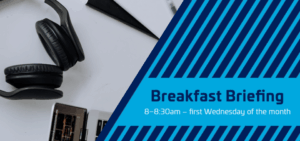Author
Tim Bradshaw, Operations Director
Sandstone First Aid Training
5 minute read
You come around the corner at work and suddenly find yourself faced with an injured member of your team. An accident with a piece of heavy machinery has occurred and your colleague is bleeding heavily.
You have less than three minutes before the blood loss will result in unconsciousness and ultimately prove fatal, unless swift action is taken. What would you do?
Reading this now from the comfort of your workplaces or home; we would like to think that our reaction in that situation would be calm and heroic. However, the reality is that our fight or flight mechanism kicks in and our adrenaline starts pumping.
- How would you react seeing a colleague in distress?
- Would you know where to find your first aid kit?
- Do you have the right kit to stop the bleed and do you know how to use it?
With over 40,000 work-related injuries and accidents taking place in workplaces across Scotland per annum (Health and Safety Executive 2023 figures); ensuring that members of your team are equipped with effective First Aid at Work (FAW) training that teaches them how to put these skills into practice whilst in a high-pressure situation is crucial.
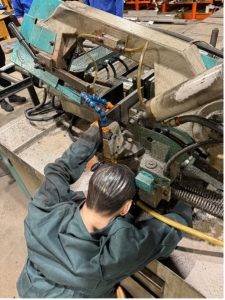
The Health and Safety Regulations 1981 states that: “all employers must provide adequate and appropriate equipment, facilities and personnel to ensure that an injured or ill employee receives immediate medical attention at work.”
However as it stands, the correlation between Health and Safety Executive (HSE) best practice and the reality of commercially available first aid training is almost none. Somewhere along the way, these guidelines have been misinterpreted and generic FAW courses are continuing to be sold, leaving companies uncompliant.
As a result, the safety of employees in the workplace has become a mere tick box exercise. Basic first aid kit? Tick. An appointed first aider? Tick. Health and safety policies tucked away in folders? Tick.
Although these are requirements by law and should be followed – HSE guidelines go further to state that every workplace should conduct its own first aid risk assessment. This is to ensure that both the training and equipment reflects the potential risks present within that workplace.
Therefore, a workplace with heavy equipment, machinery or moving vehicles and racking for example; must by definition include the risk of major bleed or crush injuries in its FAW training and should be equipped to deal with it. Does yours?
Costing the Scottish economy close to two billion pounds in 2023 (Health and Safety Executive figures 2023); work-related fatal accidents, injury and ill-health have a devastating impact on businesses and individuals alike. Particularly in the engineering industry whereby employees are exposed to greater risks from machinery, falls, handling and transport. It is therefore critical to reiterate that attending a generic FAW course does not and will not protect your employees and is not necessarily HSE compliant.
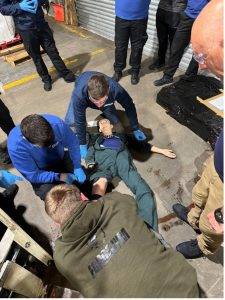
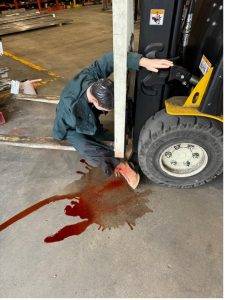
Our Chief Instructor Mike Hope and Ops Director Tim Bradshaw recently ran a First Aid Demonstration for a member of Scottish Engineering. Two employees of Hydrasun’s Precision Manufacturing Division who had recently completed and passed a three-day FAW course were launched into a relatively simple scenario. Having staged a small road traffic collision (RTC) between a car and a pedestrian in the company car park – the two members completely froze and didn’t know how to react.
This is by no means a reflection of the individuals but rather a sad indictment of the poor standard of training they had previously recieved. Research has shown that many of the crucial skills taught within first aid, including CPR, are forgotten shortly after certification (Anderson, Gaetz Masse 2011Trauma, Resuscitation and emergency medicine journal).
As FAW continues to be taught through PowerPoint presentations in sanitised, controlled classrooms – little to no practical advice is given to participants on how to apply what they are being shown on a screen in real life scenarios.
As a result of the demo, Divisional Manager Don Morrison sent 10 Hydrasun employees on the same three-day First Aid at Work course with our Chief Instructor Mike Hope. Here is what they had to say after:
“The Sandstone team simulated various potential accidents in the factory using life-like dummies complete with fake blood and injuries. The combination of excellent first aid training delivered by experienced ex forces veterans and emergency services personel using multiple scenarios has resulted in much more confident and capable first aiders.
Feedback from the Hydrasun team has been exceptional, over the course of 3 days the trainees were exposed to over 10 scenarios which gave the team lots of practical hands-on training. The training proved to be a great team-building experience too.”
We strive ourselves on delivering exceptional First Aid at Work training that is immersive and experiential. By tailoring scenarios to the risks that your workforce could face – we equip individuals with the skills they need to handle a situation under pressure. We do this by focussing on the intelligence not information:
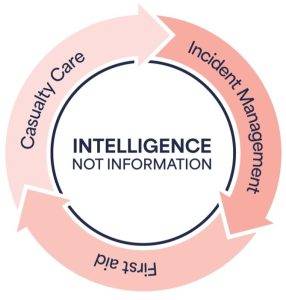
Our First Aid courses are based around a First Aid risk assessment which provides sandstone communications the intelligence they require to deliver a tailored course – be that Emergency First Aid at Work (EFAW) or First Aid at Work (FAW). We take pride in being part of your solution and providing your employees with a safe place to work.
For more information, get in touch with: [email protected]





